Book contents
- Frontmatter
- Dedication
- Contents
- About the Author
- Making My Book Social
- Acknowledgements
- Before We Begin
- About This Book
- Part I What's In Your Area Network?
- Part II The Wireless Sensor Network
- Part III The Classic Personal Area Network
- Part IV Forthcoming Technologies and Conclusions
- 16 Future and Emerging Technologies
- 17 Summary and Conclusions
- Glossary
- References and Bibliography
- Index
16 - Future and Emerging Technologies
from Part IV - Forthcoming Technologies and Conclusions
Published online by Cambridge University Press: 05 September 2013
- Frontmatter
- Dedication
- Contents
- About the Author
- Making My Book Social
- Acknowledgements
- Before We Begin
- About This Book
- Part I What's In Your Area Network?
- Part II The Wireless Sensor Network
- Part III The Classic Personal Area Network
- Part IV Forthcoming Technologies and Conclusions
- 16 Future and Emerging Technologies
- 17 Summary and Conclusions
- Glossary
- References and Bibliography
- Index
Summary
In this penultimate chapter, we discuss future and emerging technologies that didn't make the relevant sections in this book – the technologies were either too immature or sufficient information could not be obtained at the time of writing. Perhaps we can include these technologies in a future edition if they have matured sufficiently and have been widely adopted. Nonetheless, this chapter introduces a number of technologies that are definitely worth watching, as they will ultimately redefine and enhance our user experiences with wireless connectivity. The wireless industry is notorious for advancing at a modest pace, but manufacturers are always eager to launch the latest wireless-enabled gadget, a difficult dichotomy for both industries. In this chapter, we review a number of high profile technologies that have received significant press coverage, and in Figure 16.1 we take a timeline snapshot of these technologies to demonstrate their maturity level.
802.11ac
We discussed in Chapter 13, “The 802.11 Generation and Wi-Fi,” that a number of products have emerged touting .11ac “draft” capability – very much reminiscent of the 802.11n draft standard furor. 802.11n is only several years’ old and provides backwards compatibility with .11a, .11b, and .11g legacy products. Likewise, .11ac also provides backwards compatibility with the same legacy products – this is primarily due to the incumbent base of products that still very much perform, even today, the function that they were originally designed to do. If you recall from Chapter 13, 802.11b was introduced as far back as 1999, and undoubtedly it may take another decade or so for consumers to exchange their access points for newer products.
- Type
- Chapter
- Information
- Publisher: Cambridge University PressPrint publication year: 2013



